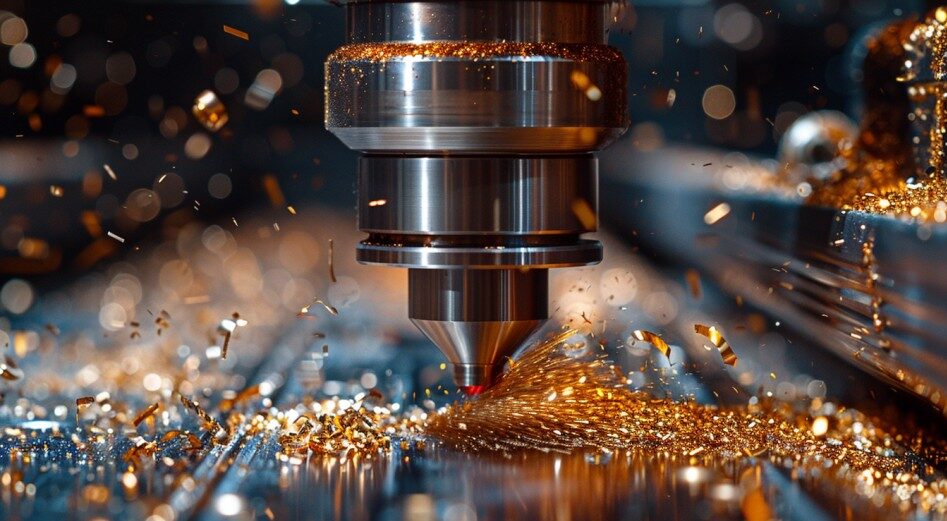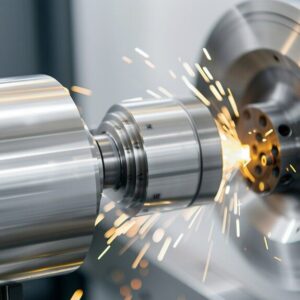CNC milling is a key subtractive manufacturing method that removes material from a solid block, including metal or plastic, to produce precise pieces. Unlike other CNC processes, milling extracts material using rotary cutting tools. CNC milling is better for holes and delicate 3D designs than CNC turning, where the workpiece rotates instead of the tool. CNC milling’s accuracy and repeatability enable even the manufacture of aerospace and electronics components.
Key Components of CNC Milling Machines
Overview of the Basic Parts
CNC milling machines have a spindle, table, axes, and control system. Strong motors control speed and torque while the spindle holds and spins cutting tools. Using the axes, the table supports and moves the workpiece exactly beneath the spindle. New CNC mills include three to five axes for movement along the X, Y, and Z axes and rotation around one or more for convoluted geometries. The control system interprets G-code from CAD/CAM software to execute accurate cutting routes.
Function of Each Component in the Milling Process
Each CNC milling machine part is important for machining efficiency. Spindle speed and torque affect cutting ability and finish. The table must be sturdy and accurate to sustain milling’s high forces. The control system controls all machine motions to transform digital designs into real components, using axes to guide the workpiece or tool path for the necessary cuts.
Types of CNC Milling Machines
Horizontal vs. Vertical Milling Machines
Horizontal milling machines allow heavier cutting tools due to their spindle orientation. This orientation makes chip removal easier and suits large cutting loads. On the other hand, owing to their vertical spindle, vertical milling machines are better for plunge cutting and detailed work on top surfaces. Vertical mills are versatile and cheaper, so smaller firms use them.
Specialized Machines
Several CNC milling machines handle multiple industrial demands beyond horizontal and vertical forms. Bed-type mills are suited for heavy-duty milling due to their stiffness. Knee mills are ideal for single-piece production and simpler processes because of their vertically adjustable knees. Ram-type mills are helpful for mold and die manufacturing thanks to their reach and flexibility. Each kind favors accuracy, accessibility, or volume output for independent industrial settings.
Suitability for Different Manufacturing Tasks
Tasks, materials, and manufacturing volume dictate machine type. For instance, automotive manufacturers choose horizontal machines for large-scale material removal. Tool and die makers choose vertical machines for precise work. Bed-type mills manage big components well, while knee- and ram-type mills are better for smaller, more complicated operations.
CNC Milling Operations
Introduction to Common Milling Operations
CNC milling uses face milling to smooth the workpiece surface, slot milling to make slots or grooves, and angular milling to cut angles. Each approach involves particular tools and milling process changes, including depth of cut, spindle speed, and tool route.
Advanced Operations
Refined processes, including HSM, micro-machining, and HFM, satisfy unique industry demands for accuracy and efficiency. HSM is commonly employed in die and mold manufacturing to rapidly accomplish smooth finishes and precise details. Electronics and medicine use micro-machining for small components with microscale characteristics. HFM boosts production while increasing feed rates, which benefits aerospace industries that value speed and precision.
Materials Suitable for CNC Milling
Common Materials Processed
- Aluminum
- Brass
- Copper
- Steel
- Stainless steel
- Titanium
- Plastics (e.g., ABS, Nylon, Polycarbonate)
- Acrylic (PMMA)
- Wood
- Foam
- Composite materials (e.g., Carbon Fiber Reinforced Plastic)
- Tooling board
So, CNC milling procedures use an assortment of materials, depending on the part’s needs. Metals like aluminum and stainless steel are celebrated for their machinability and durability. Meanwhile, plastics such as ABS and nylon are used for prototypes and impact-resistant sections.
Selecting the Right Material
Material selection requires product application, machining environment, and economics. For example, aluminum is ideal for automobile components because of its ease of machining and strength-to-weight ratio. Medical gadgets use stainless steel for durability. Remember, a machine’s ability to manage the material’s hardness and abrasiveness is also important.
Benefits of CNC Milling
Precision and Repeatability
CNC milling produces parts with unmatched accuracy and reproducibility for aerospace and medical technologies. The digital template and automated control eliminate human mistakes while producing components with precise tolerances and identical quality in big numbers.
Efficiency and Speed
CNC milling is faster and more efficient than conventional manufacturing. Automated processes make continuous production without human involvement possible. Contemporary CNC machines’ capacity to handle numerous tools and processes accelerates production and cuts turnaround times.
Need more queries regarding CNC milling or how it can serve your particular need? Contact us.




